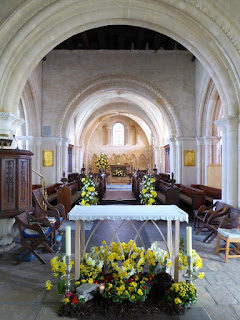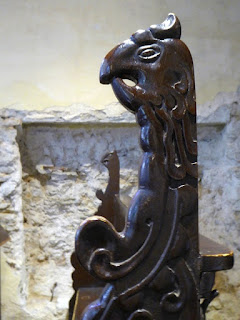You'll have to wait a while to go into the woods - with the Wodewose of the North Walsham misericord pictured above - of my annual Norfolk churches walk write-up. It always takes me some time to get the pictures and the text ready so that we can further request donations for the Norfolk Churches Trust. Suffice to say we did it, though in a rather unorthodox time-scheme which I'll mention in the chronicle. Anyway, 12 churches and 12 miles is good enough, if slightly less than usual, so if you want to give to an historically vital cause, here's the link - third time lucky, and higher up the blog entry this time - to J's JustGiving page.
I thought I'd use the opportunity to sweep up some long-withheld impressions of major churches in Devizes, Salzburg and Tallinn from earlier in the year. The first visit was on a chill, intermittently wet Easter Sunday weekend based in Lacock after warmer-weather walking. Devizes has a rather run-down feel to it, not really on the way to anywhere, though it was prosperous once. We did enjoy our lunch at a rather unusual greasy spoon, though; that's stuck in the memory.
As has major Norman masterwork St John, set in an extensive churchyard with some fine buildings around the fringe. It is, as Pevsner puts it, 'dominated by a mighty crossing tower with round stair-turret higher than the tower'.
The east end immediately catches the eye on walking in to the centre of the interior. The crossing and chancel are both unusually rich expressions of Norman style
with the east bay of the chancel interesting Pevsner with its 'wild blank arcading of intersected arches with zigzag'.
This is all the doing of Bishop Roger of Sarum, who also rebuilt the castle constructed by his predecessor as Devizes' initial raison d'etre. There are three green men among the grimacing capitals; as they're not vastly different, one will do.
To the south is the Beauchamp Chapel, immediately recognisable without and within as a cousin of the splendid Beauchamp and Tocotes Chapel at Bromham, so of the same date (1490s).
Especially interesting is how the Norman corbel table of the chancel appears as part of the chapel.
The North or Lamb Chapel is Perpendicular, but here too Normanness in the shape of massy columns appears on one side (these columns actually appear to the south of the crossing, but they're the same in design).
The 14th century nave is plain by comparison, much restored by the Victorians, and there are few other of the individual treasures which make less grand churches so memorable. Pevsner, oddly, doesn't mention these brasses (they can't be of 1788, surely?)
But there's enough in the east and in the churchyard to make this a major building. The other main church in Devizes, St Mary's, also boasts a Norman chancel but was firmly locked (we had difficulty enough getting summoning one of St John's wardens, but he came eventually).
I think of Salzburg as a city of Baroque and rococo, epitomised by the large complex of the Peterskirche
which includes what's advertised as 'the oldest eatery in Europe' - I had a good lunch there with ever-entertaining polymath Nicholas Berwin, who had also come to be impressed by The Exterminating Angel and disappointed by Die Liebe der Danae - and a churchyard beneath the castle rock. So it was a surprise to come across the Franziskanerkirche, a Gothic masterpiece remodelling a Romanesque original and then overlaid with 18th century work. The only way to get a good look at the building as a whole, since Italian-style it's hemmed in by attractive narrow streets with high buildings on every side, is to climb the Kapuzinerberg (the tower to the left is that of the Peterskirche, which shows their close proximity).
The glory here is the Gothic choir, remodelled between 1408 and 1450 and reminiscent of some of the treasures of Toulouse's Church of the Jacobins we saw at the start of the year.
The altar is Baroque, part of Johann Bernhard Fischer von Erlach's makeover. But at its centre is a Madonna of 1495-8 by that Tyrolean master Michael Pacher, whose St Wolfgang masterpiece we'd admired on our Hallstatt holiday some years back.
Dig the angels of Ottavio Mosto guarding the Franziskuskapelle, first on the right of the 'rosary' of chapels.
Probably the earliest treasure is the 12th century marble lion at the foot of the pulpit
with a man clearly struggling beneath him to plunge a sword in.
The Gothic tower was taken down a notch because it was impiously higher than that of the Cathedral. The Baroque version is nicely in tune with the rest, though,
and peers down on various alleys around the edifice.
Last but not least, the most charming interior I've seen in Tallinn, that of the medieval Lutheran Church of the Holy Spirit. Tourists all see the outside with the famous clock, which I never photographed because it always seemed to be in shadow. you'll have to make do with a shot of the octagonal tower with crow-stepped gables leading up to it, actually rebuilt after the second of two serious fires in 2002.
I was glad I paid the modest entrance fee and had the interior to myself. Its fittings date from various eras, but seem all of a piece.
The galleries with paintings by different artists and musicianly angels punctuating the scenes are 17th century
and I like the extra angel-capped posts lined up in display on the west wall.
Oddly, the choir is situated in what would normally be the Lady Chapel, and it isn't facing east since clearly the church had to be squeezed in to Tallinn's already labyrinthine medieval design. Its treasure is the altarpiece of 1483 by Bernt Notke with the Miracle of Pentecost as its centrepiece.
I have a fold-out card showing all the panels sitting in front of me as I write.
Here's a fine gryphon bench-end.
and it seems appropriate to end with a view up into the gallery where the organ's situated; the plant, I think, was part of the eco-greening theme of the Estonian Music Days festival I so enjoyed in the spring.
So, next stop Norfolk churches 167-179. If you're interested in doing some background work before this year's Norfolk selection, I'll put up again the list of previous chronicles:
Cromer to Southrepps 2015
Mileham to Bittering, 2014
Beechamwell to Gooderstone, 2013
Ingoldisthorpe to Thornham, 2012
East Rudham to Helhoughton, 2011
Wormegay to Castle Acre, 2010
Walpoles to Wiggenhalls, 2009
King's Lynn to Sandringham, 2008
Earlier walks back to 2002 BB (Before Blog).






































4 comments:
These beautiful churches, David ( and J), call to mind Jung's comment that if the Christian religion is not true it must even so be psychologically valid, since otherwise it could not have captured the minds of so many. Those hostile to religion and who deny this cut themselves off from something deep in human nature. We may not build churches like this any more, but we should open our minds not only to their architectural beauty but also to the spirit which gave rise to that beauty
Absolutely, David. Not for nothing do people write 'very peaceful' in church visitors' books: though I'm not a strict believer, I do adhere to spiritual essence, which is why some of us meditate in Westminster Abbey's Chapel of St Faith. Besides, the addiction to the detail, especially of misericords and stonecarving, is deep rooted in childhood outings. Within the basic church design there are so many quirks and variations. And the settings of rural churches, especially those we visited on this latest walk, can be amazingly beautiful.
So many treasures here, small and large. The Gothic choir of the Franziskanerkirche (if I've associated to the correct church) is like nothing I've ever seen. There is one church you show here, however, that I DID have the chance to visit, Tallinn's Church of the Holy Spirit. I did manage to get a photo of it that includes the clock, but it took several tries. Of the interior, I have a photograph of the angel-capped posts that is close kin to yours!
Yes, that's stupendous vaulting and, as I wrote, very similar to one of the churches in Toulouse we saw in January 2015. Glad you went inside Tallinn's loveliest church. I have the clockface as a fridge magnet - it was put inside a 'Welcome to Tallinn' goodie bag.
Post a Comment